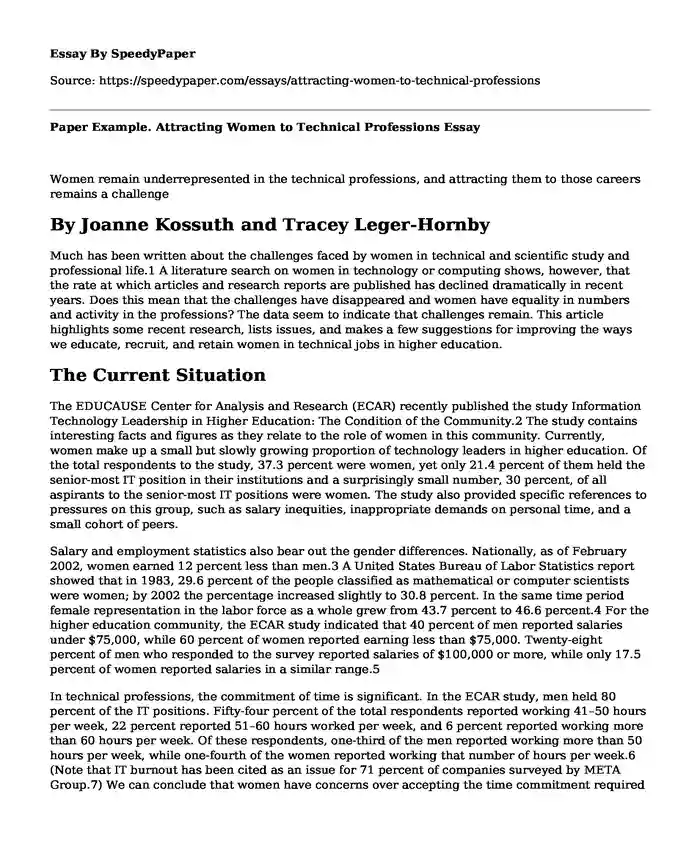
| Type of paper: | Essay |
| Categories: | Women Discrimination Job Social issue |
| Pages: | 7 |
| Wordcount: | 1686 words |
Women remain underrepresented in the technical professions, and attracting them to those careers remains a challenge
By Joanne Kossuth and Tracey Leger-Hornby
Much has been written about the challenges faced by women in technical and scientific study and professional life.1 A literature search on women in technology or computing shows, however, that the rate at which articles and research reports are published has declined dramatically in recent years. Does this mean that the challenges have disappeared and women have equality in numbers and activity in the professions? The data seem to indicate that challenges remain. This article highlights some recent research, lists issues, and makes a few suggestions for improving the ways we educate, recruit, and retain women in technical jobs in higher education.
The Current Situation
The EDUCAUSE Center for Analysis and Research (ECAR) recently published the study Information Technology Leadership in Higher Education: The Condition of the Community.2 The study contains interesting facts and figures as they relate to the role of women in this community. Currently, women make up a small but slowly growing proportion of technology leaders in higher education. Of the total respondents to the study, 37.3 percent were women, yet only 21.4 percent of them held the senior-most IT position in their institutions and a surprisingly small number, 30 percent, of all aspirants to the senior-most IT positions were women. The study also provided specific references to pressures on this group, such as salary inequities, inappropriate demands on personal time, and a small cohort of peers.
Salary and employment statistics also bear out the gender differences. Nationally, as of February 2002, women earned 12 percent less than men.3 A United States Bureau of Labor Statistics report showed that in 1983, 29.6 percent of the people classified as mathematical or computer scientists were women; by 2002 the percentage increased slightly to 30.8 percent. In the same time period female representation in the labor force as a whole grew from 43.7 percent to 46.6 percent.4 For the higher education community, the ECAR study indicated that 40 percent of men reported salaries under $75,000, while 60 percent of women reported earning less than $75,000. Twenty-eight percent of men who responded to the survey reported salaries of $100,000 or more, while only 17.5 percent of women reported salaries in a similar range.5
In technical professions, the commitment of time is significant. In the ECAR study, men held 80 percent of the IT positions. Fifty-four percent of the total respondents reported working 41–50 hours per week, 22 percent reported 51–60 hours worked per week, and 6 percent reported working more than 60 hours per week. Of these respondents, one-third of the men reported working more than 50 hours per week, while one-fourth of the women reported working that number of hours per week.6 (Note that IT burnout has been cited as an issue for 71 percent of companies surveyed by META Group.7) We can conclude that women have concerns over accepting the time commitment required to the seemingly expected exclusion of other life activities.
While the ECAR study focused on established professionals, a study by Thom, Pickering, and Thompson8 that focused on young women found the traditional model of recruiting for technical professions ignores the internal needs of women, specifically those of self-worth and self-image. Young women perceive that by entering a technical field, they will be viewed as less feminine, and they still assume that men have vastly superior technical knowledge. In addition, the study found that young women desire a career with camaraderie, support, professionalism, and courtesy, characteristics they perceive can’t be found in technical jobs.
A 2000 American Association of University Women (AAUW) publication, "Tech-Savvy: Educating Girls in the New Computer Age," made recommendations for change in the schools and professional environment. The AAUW study reported that "girls do not describe careers in computing as too challenging, mathematically oriented, or demanding. Rather, girls repeatedly say they shun them as unambitious, unchallenging, antisocial, and tedious. Girls can do it, they assert. But they don’t want to."9
A study by Margolis and Fisher, who interviewed computer science students and their faculty at Carnegie Mellon University, had similar findings. In addition, they found that the curriculum’s heavy reliance on number crunching and abstraction and its lack of regard for social and organizational skills contributed to the erosion of students’ self-confidence, particularly for women.10
Thom, Pickering, and Thompson focused part of their study on the biggest obstacles for women to enter technical fields. The top obstacles reported were the cost of training, male domination, no previous experience, lack of self-confidence, conflict with family responsibility, lack of education, lack of moral support, and no mentor. The authors stated that of these, six could be grouped under a theme of "lack of self-confidence."11
In the same study, when asked about the social factors of concern in entering a technical career, young women’s top responses included discrimination, prejudice/hostility, male domination, and schedule. Both the establishment of work schedules to accommodate women’s other responsibilities and male dominance in the profession were seen as detriments to attracting women to technical professions in both this study and the ECAR study on leadership in the IT profession.
In addition, the members of the focus groups in the study tended to have negative perceptions regarding people involved in technical careers. Some of the more prevalent comments describing people employed in technical jobs were "bad attitudes, discrimination, uneducated, stereotypically male behaviors, loners, focused, and poor communication style."12 Some of these characteristics may sound familiar to senior IT managers, but these perceptions might not exist at every point in a female student’s career.
According to Lynn Peterson at the University of Texas at Arlington, "While female interest in technical fields is often strong in middle school, frequently the number of girls participating drops by high school graduation."13 Stephanie Cole, assistant professor of history at the University of Texas at Arlington who is involved in women’s studies, speculated that a lack of role models might make entering technical fields more difficult for women.14
These observations appear to back up the conclusions of the Thom, Pickering, and Thompson study, the Margolis and Fisher study, and the ECAR study—acceptance of femininity by colleagues, self-confidence in female candidates, and the availability of social support are important factors in recruiting women to technical professions.
Implications for the Higher Education Community
So what does all this mean to the higher education community? For educators, the message is clear: the number of women receiving degrees in technical disciplines is declining. A report by the National Council for Research on Women stated that in 1984, 37 percent of undergraduate degrees in technical fields went to women, whereas by 1999, the latest year reported, a much smaller proportion of graduates, 20 percent, were women.15 Addressing some of the curricular issues, as described by Margolis and Fisher, may open doors for more young women who have an interest in technical fields. The AAUW study suggested it is never too early to address the issue of incorporating technical fluency in the curriculum and activities of young girls.
Taking the next step is crucial to extending a welcome and changing the culture. Hiring practices for student and full-time employees should include creating opportunities for women without the traditional skill sets. Those of us responsible for running IT shops in higher education settings can apply the research to the way we structure jobs and recruit new employees. In exploring factors that might make a difference in recruiting women to technical professions, the Thom, Pickering, and Thompson study suggested ways to rework technical jobs to appear more professional, and therefore more interesting, to women. By working to overcome stereotypes in the workplace, setting and managing employee expectations; providing mentors, professional support, or role models; providing positive professional exposure; and encouraging ongoing education, employers might attract more women to technical positions.16
Female applicants selected for their customer service or management skills can learn technical knowledge in alternative ways. By offering "brown bag" sessions for women in the academic community, students, faculty, and staff can demystify computers and technology in nonthreatening ways and encourage further exploration of careers in technology. We can recognize women in the profession as models for other women in the academy. Public recognition will demonstrate commitment to the idea of supporting women in technology.
There are groups actively working to expand and improve the community of women in technical fields by offering opportunities for women to explore technical careers, by fostering mentoring opportunities, and by celebrating the contributions of women in technical fields.
The Society for Women Engineers (http://www.swe.org/) provides knowledge of the engineering professions in the K–12 space and also sets up chapters at colleges and universities where women in the profession can establish relationships and mentor women planning to enter the profession. The Women in Academia group is particularly focused on this. For example, a chapter has been started at Franklin W. Olin College of Engineering, and the majority of female engineering students at Olin now have access to mentors and other less formal contacts on a regular basis.
The charter for the Association for Computing Machinery (ACM) Special Interest Group on Computer Science Education (SIGCSE; http://www.sigcse.org/) Committee on Expanding the Women-in-Computing Community was approved on February 24, 2004. The committee is charged to develop a document identifying best practices for "recruiting and retaining women in computing," highlighting relevant success stories, and fostering communication with interested computing educators in expanding the community of women in computing.
The Grace Hopper Celebration of Women in Computing 2004 conference (http://www.gracehopper.org/) is designed to bring the research and career interests of women in computing to the forefront. Presenters are leaders in their respective fields, while special sessions focus on the role of women in today’s technology domain. Past celebrations have resulted in collaborative proposals, networking, and mentoring for junior women as well as increased overall visibility for the contributions of women in computing.
Systers (http://www.systers.org/) is an informal organization for women in computing that began as an e-mail list in 1987 for women in "systems"—hence the "Systers" name. The private discussion list has more than 2,800 participants from 53 countries.
Cite this page
Paper Example. Attracting Women to Technical Professions. (2023, Aug 09). Retrieved from https://speedypaper.com/essays/attracting-women-to-technical-professions
Request Removal
If you are the original author of this essay and no longer wish to have it published on the SpeedyPaper website, please click below to request its removal:
Popular categories




